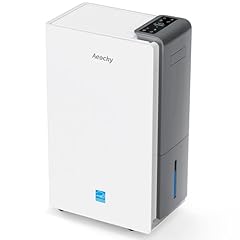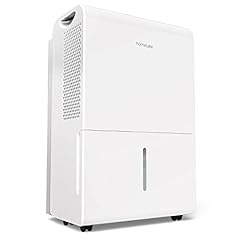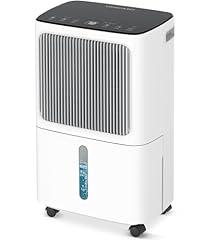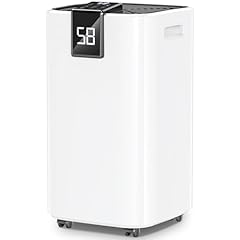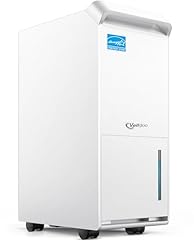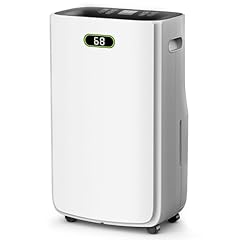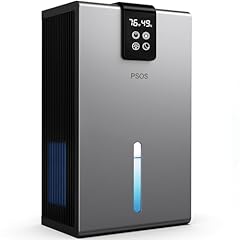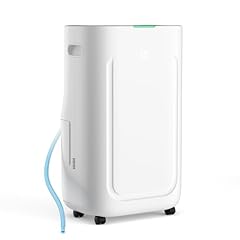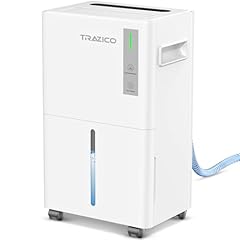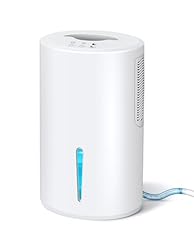-
1
Best Overall Highly efficient Energy Star rating saves on electricity.
Highly efficient Energy Star rating saves on electricity. Smart humidistat maintains optimal humidity levels automatically.
Smart humidistat maintains optimal humidity levels automatically. 3-Year Warranty for Free Replacement, way exceeds market standards!
3-Year Warranty for Free Replacement, way exceeds market standards! -
2
Popular Efficiently removes moisture from large spaces.
Efficiently removes moisture from large spaces. User-friendly with easy-to-read controls.
User-friendly with easy-to-read controls. Quiet operation suitable for bedrooms and basements.
Quiet operation suitable for bedrooms and basements. -
3
 Covers large areas up to 2,500 sq. ft.
Covers large areas up to 2,500 sq. ft. Includes a convenient continuous drain hose.
Includes a convenient continuous drain hose. Offers intelligent humidity control and dry clothes mode.
Offers intelligent humidity control and dry clothes mode. -
4
Hot Deal Covers large areas up to 4000 sq.ft.
Covers large areas up to 4000 sq.ft. Includes convenient continuous drain hose.
Includes convenient continuous drain hose. Features smart, adjustable humidity control.
Features smart, adjustable humidity control. -
5
 Energy-efficient with Energy Star certification
Energy-efficient with Energy Star certification Covers large areas up to 4,500 sq.ft.
Covers large areas up to 4,500 sq.ft. Includes a convenient drain hose
Includes a convenient drain hose -
6
 Large coverage perfect for expansive basements.
Large coverage perfect for expansive basements. Convenient 24-hour timer for flexible scheduling.
Convenient 24-hour timer for flexible scheduling. Quiet operation ideal for undisturbed environments.
Quiet operation ideal for undisturbed environments. -
7
Best Affordable Large 98 oz water tank reduces frequent emptying.
Large 98 oz water tank reduces frequent emptying. Covers up to 1000 sq.ft, ideal for large areas.
Covers up to 1000 sq.ft, ideal for large areas. Features relaxing 7-color ambient light.
Features relaxing 7-color ambient light. -
8
 Large 6.5L water tank reduces emptying frequency.
Large 6.5L water tank reduces emptying frequency. 24-hour timer allows flexible operation scheduling.
24-hour timer allows flexible operation scheduling. Child lock feature ensures safety in households.
Child lock feature ensures safety in households. -
9
 Efficient dehumidification for large spaces.
Efficient dehumidification for large spaces. Convenient continuous drainage with hose included.
Convenient continuous drainage with hose included. Versatile modes and smart humidity control.
Versatile modes and smart humidity control. -
10
 Covers large areas up to 800 sq ft.
Covers large areas up to 800 sq ft. Includes a convenient drain hose.
Includes a convenient drain hose. Features 7 colors LED light.
Features 7 colors LED light.
Overview of Dehumidifier
Ever dealt with the damp, musty odor that seeps into your living space, turning your sanctuary into something less than homely? A dehumidifier is your knight in shining armor, ready to sweep away that excess moisture and restore harmony. We want to help you find the perfect one, so we dove headlong into the ocean of dehumidifiers, exploring the depths of effectiveness, energy efficiency, and noise levels. We plowed through mountains of customer reviews and manufacturer specifications, leaving no stone unturned in our quest. This wasn't a mere skim-read of the internet; we conducted an in-depth analysis using the MECE principle, ensuring every detail was Mutually Exclusive and Collectively Exhaustive. With all this data in hand, we've curated a lineup of top performers tailored to fit diverse needs. Whether you're battling moisture in a tiny apartment or a vast basement, our top picks have got you covered.Top Dehumidifier
• AEOCKY 80 Pint Smart Dehumidifier• hOmeLabs 3000 Sq. Ft. Dehumidifier - 35 Pint• VEAGASO 30 Pint Dehumidifier with Drain HoseFAQ
Q: How does a dehumidifier work to improve air quality?
A: A dehumidifier works by pulling in humid air, removing moisture through a condensation process, and then releasing the drier air back into the room. This significantly improves air quality by reducing dampness and the potential for mold and mildew growth.
Q: What are the energy costs associated with running a dehumidifier?
A: Energy costs for running a dehumidifier can vary based on its size, usage, and your local electricity rates. However, most modern dehumidifiers are designed to be energy-efficient, meaning they use less electricity than older models.
Q: How do I know if I need a dehumidifier in my home?
A: Signs that you may need a dehumidifier include consistent dampness in certain areas of your home, mold spots on ceilings or walls, condensation on windows, musty smells, or worsening of allergy symptoms.
Q: What factors should I consider when buying a dehumidifier?
A: When buying a dehumidifier, consider the size of the space you want to dehumidify, the level of humidity, the type of dehumidifier (refrigerant or desiccant), the size of the dehumidifier's water tank, and the dehumidifier's energy efficiency.
Q: Can a dehumidifier help with my allergies?
A: Yes, a dehumidifier can help alleviate allergy symptoms. By reducing humidity levels, dehumidifiers can help control dust mites, mold, and mildew - all of which are common allergens.

